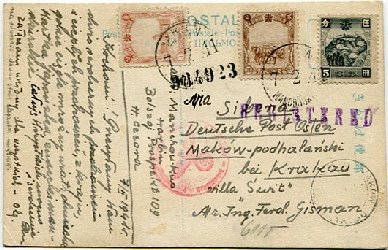
Cliquez sur les images pour agrandir -

LETTRE
7 février 1941 -
–
February 7th, 1941 -


|
Dimensions : |
138 x 88 mm |
|
|
Tarif : |
Carte postale internationale……. Recommandation………………. Total……………………………… |
10 fens 16 fens 26 fens |
|
Période de valeur : |
Du 01/4/1937 au 28/02/1942 |
|
|
Timbres utilisés : |
YT n°74, 77 et 90 |
|
|
Oblitération : |
N°43.1 Harbin 07/02/1941 |
|
|
Période d’utilisation : |
Du 09/04/1936 au 25/09/1944 |
|
|
Indications : |
« Via Siberia » à la main et cachet « REGISTERED ». |
|
|
Arrivée : |
Cracovie - Marque de censure allemande |
|
|
Size : |
138 x 88 mm |
|
|
Rate : |
Foreign postcard………………. Registration…………………….. Total…………………………….. |
10 fen 16 fen 26 fen |
|
Period of rate : |
04/01/1937 to 02/28/1942 |
|
|
Stamps : |
SG n°67, 80 and 95 |
|
|
Postmark : |
N°43.1 Harbin 02/07/1941 |
|
|
Period of use : |
04/09/1936 to 09/25/1944 |
|
|
Instruction : |
Handwritten « Via Siberia » and handstamp « REGISTERED ». |
|
|
Arrival : |
Krakow - German censor mark. |
|
Cette carte postale est l’un des derniers courriers qui vont transiter par la Sibérie pour rejoindre l’Europe. Elle part de l’enclave polonaise de Harbin le 7 février et arrivera environ quinze jours plus tard. L’oblitération d’arrivée à Cracovie ayant été mal frappée, la date précise restera inconnue.
En septembre 1939, Cracovie tombe aux mains de la Wehrmacht à la suite de l'accord de partage de la Pologne entre Hitler et Staline. Elle devient la capitale des territoires occupés polonais non intégrés au Reich. Le gouverneur général Hans Frank aménage des camps de concentration dans les environs, surtout à Plaszow. Bien que Cracovie ait été globalement préservée des bombardements et de destructions massives, elle a souffert de la perte de nombreux habitants qui furent déportés (1).
(1) Source : Grand Larousse Universel, Vol 4, pp 2740-

This postcard was one of the last letters to reach Europe via Siberia. It left the Polish enclave of Harbin on February 7th, and arrived about a fortnight later. The exact date of arrival in Krakow is unknown, as the postmark was incorrectly struck.
In September 1939, Krakow fell into the hands of the Wehrmacht following the agreement between Hitler and Stalin to partition Poland. It became the capital of the occupied Polish territories not integrated into the Reich. Governor General Hans Frank set up concentration camps in the surrounding area, especially in Plaszow. Although Krakow was largely spared the bombardments and massive destruction, it suffered the loss of many of its inhabitants who were deported (1).
(1) Source : Grand Larousse Universel, Vol 4, pp 2740-